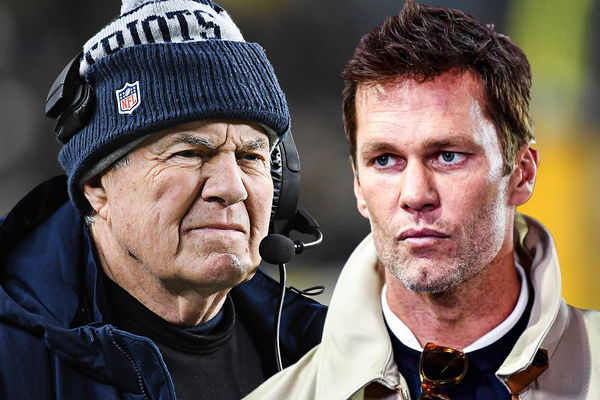
via Imago
Credits – Imago

via Imago
Credits – Imago
“He is one of the all-time great Patriots and the best guard I ever coached.” Those were Bill Belichick’s thoughts on a player who had spent his first nine years as a Patriot serving as a consistent shield for Tom Brady. Logan Mankins was the heart and soul of the Patriots’ O-line during their entire Super Bowl drought (2005-2013). A six-time Pro Bowler and a six-time All-Pro played all of his 130 regular-season games and 17 postseason clashes. Whether it was a torn ACL or any other injury, Mankins never skipped his gridiron duties, even if his body needed rest. Still, in 2014, the Patriots, out of nowhere, traded their future Hall of Famer, leaving the whole Patriots Nation and Tom Brady baffled.
Patriots sent their Pro Bowl guard to Tampa Bay in exchange for TE Tim Wright and a fourth-round pick. Mankins was still only 32 at that time, so the news of him getting traded did surprise a lot out there. However, as time went by, it was the economics behind his deal that were the driving force of this trade. Mankins was entering the 4th year of a six-year, $51M extension signed in 2011. That season, he was set to count a $10.5M cap hit against the salary cap. With his trade, the Patriots saved $5.775 M. So, in an effort to save some money, the Patriots sacrificed their most reliable guard. To be honest, money wasn’t the only reason the Pats had to throw out their nine-year veteran guard.
New England was suffering a lot with their TE position because of Rob Gronkowski’s consistent injury problems. Prior to Mankins’ trade, Gronk had missed 14 games over the past two seasons. So, when the opportunity to get a 6-foot-4, 220-pound Wright came up, the Pats didn’t tether. However, Wright didn’t do much playing behind Gronk. The Patriots’ legendary TE logged an All-Pro campaign while Wright sparingly appeared in 16 games. Caught 26 passes for 259 yards and 6 TDs, and that’s it.
ADVERTISEMENT
Article continues below this ad
Tim was released the following season again to save money. As for the 4th-round selection, the Patriots used it on Trey Flowers. Flowers was a two-time Super Bowl Champion before the Pats in 2018, to sign a mega deal with the Lions. Considering everything that happened around the Mankins trade, the soon-to-be Patriots Hall of Famer finally chose to break his silence. He shared his true thoughts on being traded at the peak of his career. “Everyone knew what was going on. It was one of things…the business side of football..I have no ill will. I loved playing for Bill Belichick. I loved playing with Tom Brady..I had a great time, and I would do it all over again tomorrow,” Mankins revealed.

via Imago
December 15, 2024, Philadelphia, Pa, USA: December 15, 2024: Tom Brady during the Philadelphia Eagles vs Pittsburgh Steelers at Lincoln Financial Field in Philadelphia PA. Brook Ward / Apparent Media Group Philadelphia USA – ZUMAa234 20241215_zsa_a234_048 Copyright: xAMGx
This will be the third straight year Mankins is a finalist for the Patriots Hall of Fame. He doesn’t know whether his turn will ever come. But he is hella proud to be included every year. Mankins is a true Patriot at heart. If he wasn’t, then how could he have ever played with a torn ACL for a whole campaign?
ADVERTISEMENT
Article continues below this ad
Logan Mankins defied his body to play a whole season with a torn ACL
Mankins was in a contractual dispute with the Pats before the 2011 season. He had just been given a franchise tag worth only $10 M. But soon after, Mankins got a historic deal. At that time, he was the highest-paid guard in the whole NFL. So, there was a chip on his shoulder to prove his worth in the first year of his mammoth contract. However, in the first game of the season, Mankins tore his ACL on his right knee. Despite the pain, Mankins didn’t miss a single game. He was only rested for the season finale when the AFC East was already locked up. Got voted to the Pro Bowl, All-Pro, and even led the Patriots to Super Bowl XLVI.
After the season was over, Mankins revealed no one had a clue that he was playing through an ACL. It was something he kept private because of his grit and determination to keep on playing. “It didn’t bother me enough not to play. My job was to play football. If the coach wanted me to be out there. I’d be out there. I wasn’t getting paid to watch on the sidelines,” Mankins revealed. Later, it was found that Mankins’ ACL had only worsened in the playoffs.
ADVERTISEMENT
Article continues below this ad
What’s your perspective on:
Was trading Logan Mankins a necessary business move, or a betrayal of loyalty and dedication?
Have an interesting take?
In their postseason win over the Broncos, Mankins tore his medial collateral ligament in his left knee. This led him to play in the Super Bowl, which they lost to the Giants, despite having torn ligaments in each knee. Mankins’ toughness was always deeply rooted in him from childhood. His father used to tell him, “If you can go to work, you go to work. Just tape an aspirin to it and you’ll be all right.” Those words were Mankins’ mantra. He may have been unfortunate not to win a Super Bowl, but still, he did enough to go down as one of the greatest guards of all time.
ADVERTISEMENT
ADVERTISEMENT
ADVERTISEMENT
ADVERTISEMENT


"Was trading Logan Mankins a necessary business move, or a betrayal of loyalty and dedication?"